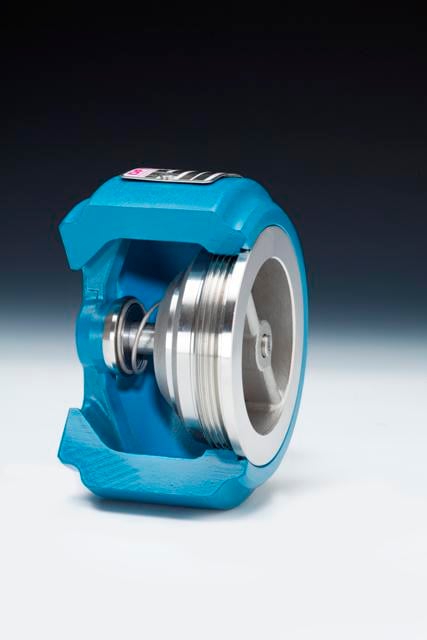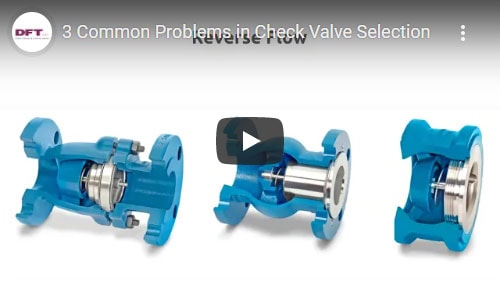Category Archive: Check Valves
Design Elements to Consider when Selecting a Check Valve
Check valves perform a crucial function in pumping systems by permitting the forward flow of water when open, and preventing reverse flow when shut. When selecting a valve for your water and wastewater pumping system, you will likely want one that not only executes this task, but also does so efficiently.
Check valves should minimize energy consumption and also protect the system from pressure surges caused by water hammer. They should also suit your particular application. The two common types of check valves to examine are silent or in line check valves and swing check valves.
3 Common Problems in Check Valve Selection
Did you know that, unlike other types of valves, check valves continue to work if a plant loses electricity, air, manpower, or all of the above? They come in a wide variety of sizes, materials, and end connections, and can be used in countless applications.
So why is it that they’re often improperly sized or selected? It’s because check valves are only as good as their application. Oftentimes the problems with a check valve are not related to the valve itself, but application and other factors. So when you’re problem solving or replacing a check valve, keep these three common problems in mind:
Water Hammer
Water hammer is one of the most common check valve problems. Water hammer is a pressure surge that’s caused when a liquid or gas is forced to stop or change direction suddenly, and often occurs when a valve is suddenly closed at the end of a pipeline system. This can result in both noise and vibration, which can in turn lead to damage and additional maintenance or repair costs.
Water hammer can be prevented, however, by using a faster-closing check valve that stops the pressure surges and shock waves that can damage and rupture equipment. Our silent check valves in particular are known for their effectiveness in preventing and in many cases eliminating water hammer.
Reverse Flow
Reverse flow is another common check valve problem and can be extremely costly, especially when it occurs at the discharge of a pump, causing the pump to spin backwards.
Is Your Check Valve Oversized for Your Application?
In a recent blog post, we discussed some of the common check valve problems, and the fact that many of them are not related to the valve itself, but with the selection and/or application of the valve.
One of these problems is oversizing that can lead to a host of problems. Such issues include excess pressure that will wear out the valve and lead to extensive maintenance costs or early replacement needs. This is because the flutter, caused by vibration and/or instability, will rapidly damage the valve.
The Cause of Valve Oversizing
Often, people will size a check valve based on the pipe diameter, which is what leads to oversizing. Not only does this create performance issues, but it means you’re overpaying for a valve much larger than you need. Initial costs and ongoing maintenance costs increase as a result.
Therefore, the rule of thumb is: size your check valve for the application. This will ensure that no fluttering of the disc occurs, and will provide the longest valve lifespan. When a check valve is sized the way an on/off valve is sized, it ignores the fact that the flow conditions of a check valve determine its internal performance.
Application Factors in Check Valve Sizing
DFT’s ALC and WLC Wafer Check Valves
Water hammer and reverse flow can be ongoing issues for large buildings and industrial piping. In the majority of cases, an unreliable double door or butterfly check valve was utilized and the results are these damaging issues. Double door or butterfly check valves often times incur failure of the door spring or hinge pin; leakage from misaligned doors and seats; reverse flow; and even internal parts flowing down stream.
The harming effects of water hammer include loud noise and rapid vibration to pipe collapse. Reverse flow can damage pumps and motors, a costly proposition to any company.
DFT Inc.’s Pulp and Paper Check Valves: Write On!
If you think of paper manufacturing (and its raw material, wood pulp), you probably think of trees, huge mills, and giant rollers. Water and liquid chemical delivery systems might not be the first things that come to mind. Both, however, comprise important steps in both pulp and paper production. Quick explanation: wood pulp is made up of certain fibers from wood, separated out from the main piece. This separation can be achieved through a number of different methods, one of which is through chemicals specially intended to break down the raw wood, while leaving the key cellulose fiber intact. As you might imagine, these chemicals can be fairly harsh, which is why DFT Inc.’s severe service check valves are the perfect replacement for standard swing check valves on batch digester systems.











